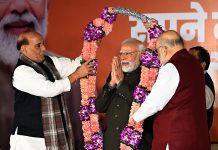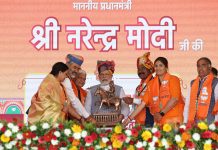In recent years the World Bank has often debated good governance as a general tool in the international development process and its perspective of good governance is “the manner in which power is exercised in the management of a country’s economic and social resources for development”. The government led by Prime Minister, Narendra Modi has knowingly or unknowingly followed what World Bank has to say about good governance. The Government has completed three years in office, leading to release of flurry of scorecards on its performance or lack of it. When we look at the big picture, we find that the underlying motif of the government has been on ‘minimum government, maximum governance’. The Modi Government has been at the top as far as garnering space on social media, audiovisual media or broadcast media is concerned.
Mann Ki Baat
Modi’s ‘Mann Ki Baat’ is first such initiative in India where a top leader addresses millions, that too periodically. The programme even featured the then US President Barack Obama during his visit to India. Every minister and every ministry is now on Twitter. The government has tried to keep away from most spheres of economic activities by shunning over-regulation coupled with plans to do away with loss making PSUs. While this has led to minimum government, the government has over stretched its role in certain activities relating to public welfare, raising standards of living, enhancing per capita income, improving law and order situation, provision of basics like education, health, civic amenities and empowerment of its citizens. The move to provide LPG connections to those who still use firewood or kerosene stoves won appreciation particularly from women. Initially started as a ‘Give It Up’ campaign, the Petroleum and Natural Gas Ministry barred subsidy to customers who earn more than Rs. 10 lakh per annum. The amount saved was used to give over five lakh new LPG connections to those who were deprived of LPG connections.
Aadhar for transparency
The focus area for maximum governance is to ensuring transparency in methods by linking ‘Aadhaar’ with various benefits. For maximum governance, the government has meant an equal relationship between the Centre and the States by abolishing Planning Commission. Doing away with the Planning Commission and forming a National institution for Transforming India is a new approach for economic transformation. The greater devolution of finances to the States, involving States in Union Policy through Central schemes like Skill India, Swachh Bharat, digitalization and so on speak volumes about maximum governance. The one rank one pension scheme acceptance and go ahead to bullet train are also important decisions of this regime.
GST-the game changer
The Goods and Services Tax is a step in that direction. The GST Council has already agreed upon the rates applicable on 500 services and about 2,000 goods. Rates of GST range from zero per cent, 5 per cent, 12 per cent, 18 per cent and 28 per cent for all goods and services.Twelve States have already passed their respective SGST legislations while the Centre has passed its CGST law .The rest of the States are expected to pass their SGST laws in near future. A document spelling out the process of transition from VAT to GST would now be needed to see a logical conclusion to a 17-year journey which will culminate in a landmark tax reform. By subjecting all taxable goods and services to just four or five rates, our tax system would not have asked for more. After GST regime, the manufacturing side, FMCG goods will attract a lower GST, while in the case of capital goods, cement, metals and pharma there is almost no change in levy. However, B2C services that would move into a higher rate bracket (from the current level of 15 per cent to 18 per cent or 28 per cent) and will become expensive. These could include telecom, finance, AC restaurants and business class travel. However, in the long run, the uniform tax rate would benefit all.
Little doubt that a majority of 2,00,000 citizens surveyed across the country on the performance of Modi Government that completed three years on May 26 this year point out that they were satisfied with its performance.
However, the majority number which stands at 61 per cent is down from 64 per cent that was seen last year and 68 per cent satisfied population in the first year of Modi Government. The ruling Bharatiya Janta Party has mostly been on a winning spree during these three years clearly exhibiting that the ‘achhe din’ have not only been for people but for the party as well. Local Circles, a citizen engagement platform conducted the survey in tier one, two and three cities and villages of the country to evaluate performance of Modi Government during the three years. The survey paints a healthy picture for the government as 61 per cent say that the government has come up to their expectations while 17 per cent people say that the government has exceeded their expectations in the three years. About 44 per cent of those surveyed say that the government performed on the expected lines. About 59 per cent of the people surveyed observe that the government would fulfill the promises made in the election manifesto. About 65 per cent of people felt that the government handled Parliament effectively and took Opposition along to deliver the key Bills to bring about long-awaited economic reforms. The survey had another interesting data to share as 69 per cent of those polled say that individual MPs still remain disconnected from their constituencies.
Swachh Bharat campaign
Significantly, though the recently released Swachh Survekshan 2017 reported that 80 per cent people say that the clean India drive had made their cities cleaner but the LocalCircles survey says that only 35 per cent gave credit to the Swachh Bharat campaign for bringing cleanliness, about 57 per cent disagreed with the suggestion. The pet project of Modi, Swachh Bharat mission got wide public support, particularly in social media after celebrities joined the Clean India challenge and began tweeting and liking the Facebook pages. Not just stopping with cleaning the locality, the government has built more toilets and given the social measure wide publicity. The Modi government created a separate ministry for rejuvenation of Ganga and the Namami Gange project with a budget of 20,000 crores over a period of five years has been cleared.
RERA aftermath
The new Act called Real Estate Regulatory Authority Act, apart from making the process transparent and keeping checks and balances in the form of a Real Estate Regulatory Authority, the new legislation is boosting confidence of buyers in real estate. When housing sector contributes to nine per cent of GDP, this law, if effectively implemented by the States, would be a game-changer in the housing sector.
Already many states have implemented this Act including some none BJP governments. The government has kick-started the process by short-listing 20 cities in the first phase and earmarked 7060 crores for the project.
Job creation still remains a major concern for many as only 21 per cent people thought that the government was doing enough on the job creation front. About 65 per cent of citizens believe that infrastructure development in the fields of irrigation, roads and telecom has become faster in the last three years. On the success of demonetization, about 39 per cent of those who participated in LocalCircles survey agreed with the suggestion that demonetization helped reducing corruption. However, 51 per cent of people believe that demonetization was a decision in right direction. They believe that though demonetization may not have reduced corruption, it helped fighting black money.
Jan Dhan, Make in India
The Modi Government’s initiative in the form of Jan Dhan Yojana for 100 per cent financial inclusion has got laurels for the government. Now anyone can now open an account in a bank, thanks to this financial inclusion scheme. In just 14 days of its launch, Jan Dhan Yojana found a place in Guiness Book of World Records for maximum number of accounts opened in a week. Another project of Modi Government ‘Make in India’, to make India the manufacturing hub, the government is taking efforts by easing foreign investment norms, revamping labour laws and cutting down the red tape. India has conducted road shows abroad and a number of multi-nationals have pledged their support. The survey shows that a massive 81 per cent of people feel that India’s image and influence in the world has improved under the Narendra Modi government. This is still lower than last year, when the number stood at 90 per cent. About 64 per cent of people supported the Modi government’s Pakistan policy in the backdrop of last year’s surgical strikes. In the last year’s survey, before the surgical strikes were carried out in Pakistan-
occupied Kashmir, only 34 per cent approved of the way India handled Pakistan However, conversely, dissatisfaction has also risen. During the last year only 36 per cent citizens said the government’s performance was below expectation. This has gone up to 39 per cent in the third year.
Cause of concern
What could be a cause of concern for the Modi Government would be that 66 per cent of citizens believe that the prices of essential commodities and cost of living have gone up in the three years of the Modi government. This is in spite of the fact that inflation has come down to below three per cent. Only 28 per cent citizens agree with the price index readings.
Incidentally, 38 per cent people last year gave credit to the government for keeping the prices down. Another cause of concern could be that about 60 per cent of participants in the survey felt that crime against women and children has not come down. Only 28 per cent people say that crimes against women and children have been checked.
letters@tehelka.com














